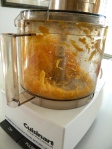Undoubtedly, asparagus is my favorite spring vegetable. At this time of year I always look for it at the Farmers’ Market. There was fresh asparagus at the market on Sunday but I didn’t buy it. Instead, I stopped at my neighborhood grocery store and bought some. I didn’t buy it there because the price was better. It was actually about the same. I bought it because it was from Durst Organic Growers, local fourth generation farmers from the “Hungry Hollow” area at the mouth of the Capay Valley.
Capay Valley, about 45 miles from where I now live, is where I lived during my last two years of High School. We had a 40-acre Almond ranch there and the elementary and high School, in Esparto is where all the kids from up-the-valley and all the areas surrounding Esparto went. Some kids spent an hour on the bus getting to school and another getting home. The buses carried both elementary and high school (there was no middle or Jr. High) kids, so if you were from a large family like me, you rode to school on the same bus as your brothers and sisters. The schools were very small by today’s standards, about a couple hundred of us at the high school and that’s probably being generous. My senior class had thirty-two. It was a wonderful place to live in those days, a little like Mayberry RFD. The Durst kids went to school with my younger sisters. Some of their cousins were in my class. In small towns everybody is somebody’s cousin, unless like me, you moved there. So maybe it was nostalgia that brought me to buy their asparagus. But really, I don’t think nostalgia was the reason. Durst Organic Growers bring beautiful products to market so while nostalgia may have played some small part in my choice I was really just looking for the very best asparagus available. The only asparagus I’ve had that beat theirs was some wild asparagus I found growing in a meadow along a trail where I was walking. It was so beautiful, some of the spears had leafed out into their fern-like foliage and tucked below it were perfectly shaped spears, some about 7 inches tall and no bigger around than a pencil. The temptation was too great. I had to to taste this perfection. I broke off the spears and ate them, slowly, one by one, relishing their taste and texture. They were sheer heaven. I don’t know what there is about foraging food but to me it always tastes much better than anything I can buy.
 To celebrate my asparagus bounty I grilled some and added it to a penne pasta recipe I came across on one of my recent digs (through recipe clippings of which I have more than I probably need). This is not heavy, although with all that cream one would think it would be. I didn’t feel it over whelmed the vegetables. I could still taste their bright spring flavors.
To celebrate my asparagus bounty I grilled some and added it to a penne pasta recipe I came across on one of my recent digs (through recipe clippings of which I have more than I probably need). This is not heavy, although with all that cream one would think it would be. I didn’t feel it over whelmed the vegetables. I could still taste their bright spring flavors.
Penne with Asparagus, Peas, Mushrooms & Cream
8 – 10 servings
1 lb thin asparagus
3 tablespoons extra-virgin olive oil, plus more for grilling
Salt and freshly ground pepper
3 medium shallots, minced
¾ pound shitake mushrooms, stems discarded and caps thinly sliced
2 ¼ cups heavy cream
1 ½ lbs penne rigate
1 ½ cups fresh or frozen baby peas (if frozen thaw them before using)
¾ cup freshly grated Parmigiano-Reggiano cheese
3 tablespoons finely chopped flat-leaf parsley
1. Preheat a cast-iron grill pan. Brush the asparagus with olive oil and season lightly with salt and pepper. Grill the asparagus over high heat, turning until it is lightly charred and very tender, about 6 minutes. Cut the asparagus to 1-inch lengths. (I used my BBQ instead of the cast-iron grill pan)
2. In a very large, deep skillet, heat the 3 tablespoons of olive oil. Add the shallots and cook, stirring once or twice until the mushrooms are golden and tender, about 8 minutes. Add the cream and bring to a boil. Simmer until slightly reduced, about 4 minutes.
3. Meanwhile, in a large pot of boiling salted water, cook the pasta until al dente. Drain the pasta, reserving ¾ cup of the cooking water.
4. Add the pasta to the skillet along with the asparagus, peas and grated cheese and toss well. Add the reserved pasta water and simmer, tossing, until the pasta is nicely coated. Season the pasta with salt and pepper and stir in the parsley. Serve right away.
More asparagus ideas from Annie:
Grill’n Between Storms
Early Egyptians, Greeks and Romans Prized Asparagus. Me too.
Slow Post for a Quick Stir-Fry
38.580461
-121.530234
Share or print this post:
 The recipe is quick and easy taking a little over 30 minutes to complete. Grated winter squash is simmered with polenta and bay leaf until they are tender, then you add a little butter and black pepper and the polenta is done. While the polenta cooks, you brown the sausage and caramelize the onions. What could be easier? Add a nice green salad and dinner is served.
The recipe is quick and easy taking a little over 30 minutes to complete. Grated winter squash is simmered with polenta and bay leaf until they are tender, then you add a little butter and black pepper and the polenta is done. While the polenta cooks, you brown the sausage and caramelize the onions. What could be easier? Add a nice green salad and dinner is served.
















